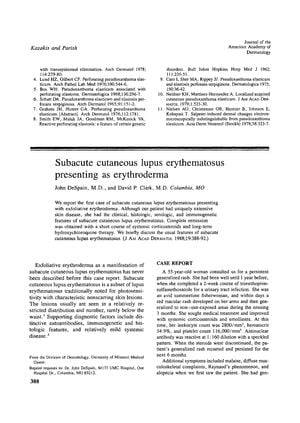Subacute cutaneous lupus erythematosus presenting as erythroderma
August 1988
in “
Journal of The American Academy of Dermatology
”
subacute cutaneous lupus erythematosus SCLE erythroderma alopecia trimethoprim-sulfamethoxazole systemic corticosteroids emollients antinuclear antibody anti-Ro antibodies anti-La antibodies low complement levels skin biopsy oral prednisone ultraviolet protection hydroxychloroquine lupus hair loss Bactrim steroids moisturizers ANA prednisone Plaquenil

TLDR A woman with subacute cutaneous lupus erythematosus had widespread skin symptoms triggered by medication and sunlight, which improved with specific treatments.
In 1988, John DeSpain and David P. Clark described the first case of subacute cutaneous lupus erythematosus (SCLE) manifesting as exfoliative erythroderma in a 55-year-old woman. The patient's condition, which included a generalized rash, malaise, musculoskeletal issues, Raynaud's phenomenon, and alopecia, developed following sun exposure and treatment with trimethoprim-sulfamethoxazole. Although initial treatment with systemic corticosteroids and emollients led to improvement, her symptoms recurred after stopping steroids. Laboratory tests confirmed the presence of SCLE through positive antinuclear antibody, anti-Ro and anti-La antibodies, and low complement levels. A skin biopsy was consistent with SCLE. The patient achieved complete remission within 3 months after being treated with oral prednisone, ultraviolet protection, and hydroxychloroquine. This case was notable for the extensive skin lesions and erythroderma, which had not been previously associated with SCLE, and suggested that drugs and ultraviolet light might act as triggers for the condition.
